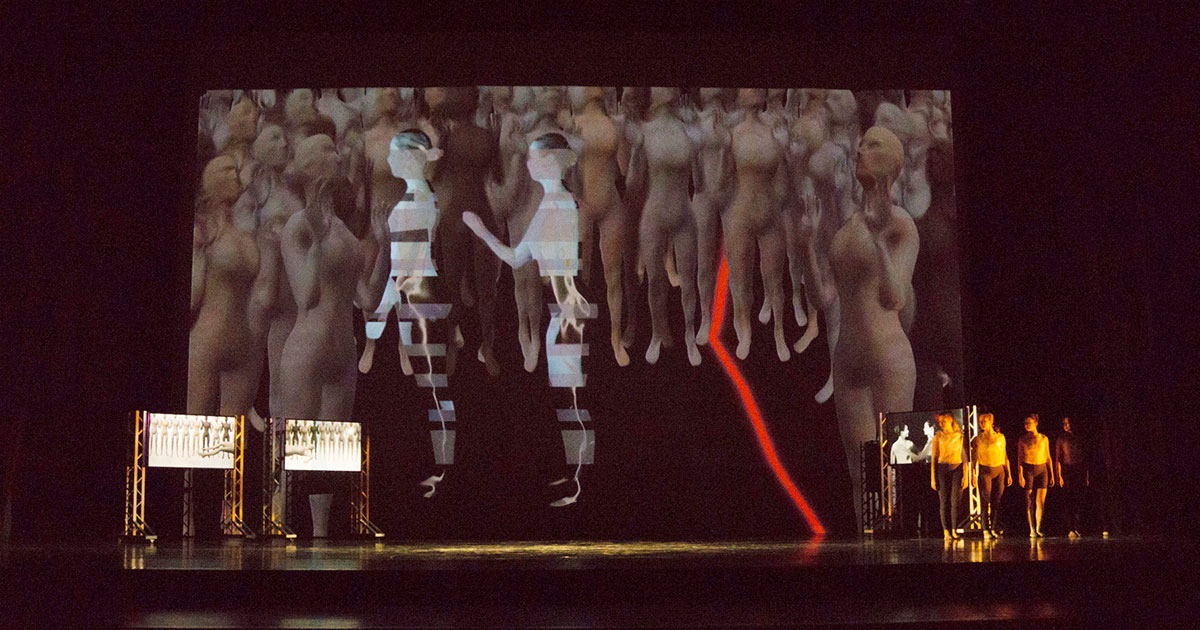Dance, video collaboration continues to echo around world

LAWRENCE – For University of Kansas professors James Moreno and Ben Rosenthal, their $15,000 grant from the Hall Center for the Humanities in 2013 to develop a collaborative dance and video project is the gift that keeps on giving.
They spent the money to create a three-part, three-year, three-performance hybrid dance-audio-video project called “Human, Next” that they staged first on the KU Lawrence campus with the University Dance Company, then in New York and Chicago with professional dancers. Since that time, the audio-video portions have continued to be shown as stand-alone artworks at galleries and festivals around the world. This week in Brazil, all three parts of the video Moreno and Rosenthal co-created will be shown together for the first time as part of the fourth international video-dance exhibition known by the acronym IMARP, which stands for Images in Motion, in the city of Ribeirão Preto, in São Paulo state.
Rosenthal is an associate professor and director of graduate studies in the Department of Visual Arts. Moreno is associate professor and dance studies coordinator in the Department of Theatre & Dance. Both arrived on campus in fall 2012 and found they responded to each other’s work.
“I saw James' work, and I was really interested in the ways in which he was manipulating the body,” Rosenthal said, “I had been thinking about the way in which the body is changing with technology – existing as this hybrid space. We both were interested in those conversations and had common reference points.”
The grant kicked off a long-term artistic research collaboration that continues to this day. It didn’t take long before the first iteration of “Human, Next” took shape.
“The first one was in fall 2013, here with the University Dance Company performance at the Lied Center,” Moreno said. “Choreographing and setting a performance on the student groups was kind of the testing ground for a more professional outing. So we took it to New York City in 2014 and then to Chicago in 2016.”
In performance, the work involved dancers on stage with the original video that Moreno and Rosenthal created projected onto both a large backdrop and upon three 3-by-5-foot video monitors that were mounted upon rolling stands, moving around the stage with the dancers.
“It's pretty much three chunks, three different iterations or phases, of it,” Moreno said. “The questions were so big for Ben and I, like what is embodiment? What is corporeality? And what happens in our present time, where so much of our time is virtual and digital, and how does that affect the body and our way of thinking about the body? As we sit at the desk and as our minds enter the interwebs and online virtual bodies, how is that affecting society and our culture?”
Both men say their creative process was truly collaborative, as they shared ideas about creating the sound, movement and computer-generated visuals that make up the piece(s).
“Usually, in dance-media collaborations, the choreographer is in charge, and the video person is really a technician who's serving the needs of the choreographer,” Rosenthal said. “Or in art-based scenarios, the artist is in charge and the choreographer is hired to do something. This makes for a hierarchy of creation, or a division of labor, that is not truly collaborative in the way in which we were able to finish each other's sentences — at times literally, and then also within the work.
“The animated bodies that the dancers performed with were as much a part of the choreography landscape and as much a part of the space as the physical bodies, and vice versa. It was really unique to be able to participate in a project like this. There are very few works of this type that exist. Not many like choreographers are willing to be as brave as James was and as willing to share space. We both, I think, lost a sense of individual authorship, which is so deeply tied to like the ego of the artist. So for me it was really moving to be able to just make work with somebody and for us to be equals and interested in the outcomes, not connected to these metrics of authorship.”
The three pieces total about 45 minutes in length. The audio for the first phase was created entirely, Rosenthal said, by manipulating Apple Macintosh computer system sounds, i.e., the startup fanfare or a button click. The second and third phases are composed using recordings exclusively from the body and a hybrid of body/breath and technological system sounds, respectively.
While the authors consider that the three live performances of “Human, Next” were successful, they’re also pleased that the audio-video portions continue to make their way around the world, as this week in Brazil.
“The nice thing about the video artworks is they allow us to continue to share the conversation and the work globally with just a digital transfer of files so they can screen at festivals and events and in many different cultural contexts,” Rosenthal said, “and that's what's happened here in Brazil.”
As Rosenthal sees it, the Hall Center continues “getting a bang for their buck” from the original grant.
Photo: Still taken during a performance of “Human, Next.” Courtesy of Ben Rosenthal